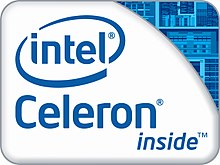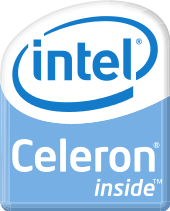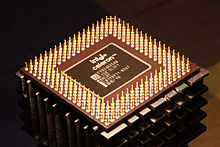Intel Celeron
Intel Celeron is a brand name of the company Intel for less powerful main processors . Celeron CPUs were designed primarily for inexpensive home and office computers that have comparatively low performance requirements.
history
The tradition of low-cost processors
Even before the first Celeron CPU came onto the market in 1998, Intel had several low-cost variants of its current processor generation for the mass market in its sales program - it is assumed that one of the goals was to replace the previous processor generation with the current one more quickly . These low-cost CPUs regularly disappeared quickly from the market as soon as the new generation was established. A complete concept for serving the market for the “small budget” was only created with the marketing of the Celeron.
As early as 1979, at the time of the 8-bit computer, Intel brought out a cheaper version of the 8086 , the 8088 , which had an eight-bit data bus instead of a 16. At that time, the goal was still to remain compatible with the then huge eight-bit market. This was one of the reasons why the 8088 was selected as the CPU for the first IBM PC . Intel also had the same approach with the successor 80186/80188 , which played a role primarily for embedded systems and was only rarely used in personal computers (for example from Siemens). In 1988, Intel again presented a less powerful version of a current generation of processors, the 80386SX, derived from the 80386 processor . It was an 80386 with the bus interface of an 80286 and thus contributed to the spread of the expanded 386 instruction set. This was also repeated with the 80486 with the 80486SX, which differed from the 486 in that it had a floating point unit that was mostly deactivated by Intel due to a defect and was therefore sold much cheaper. After that there were no cheap versions for a long time until the Celeron CPUs came onto the market.
Development of the Intel Celeron processor
Finally, in 1998, Intel presented the first Celeron based on the P6 architecture and derived from the Intel Pentium II . However, the first Celeron had to do without an L2 cache, which made it very slow. In the relatively short term, Intel followed up with the so-called A variant, which had a 128 kilobyte L2 cache that was small but connected to the full processor clock. Shortly before the turn of the millennium, these processors were very popular with enthusiasts because they had a high overclocking potential and could stand up to the largest Pentium II models for a fraction of the price. A descendant of the Intel Pentium III followed later , which in 2000 also moved to the 370 socket specially set up for the Celeron processors .
With the introduction of the Netburst architecture , a new Celeron based on this same architecture was later presented. In particular, the clock rates were increased here, which also led to an increased heat emission from the Celeron processors. In the course of equipping all of Intel's microprocessors with a model number, new low-cost processors were given the name Intel Celeron D from 2004 , with the D standing for "desktop".
Since the high power consumption of the entire NetBurst architecture was not solved by the Prescott core and on the other hand, the mobile processors in the form of the Pentium M have been very successful, developed Intel derived from these mobile processors Core microarchitecture . Since spring 2007, inexpensive processors with the name Intel Celeron based on this architecture have also been sold, which compared to the Celeron D have a significantly reduced power consumption with a simultaneous increase in performance.
Behavior of the competition
Intel's main competitor in the x86 market, AMD, has also adopted Intel's marketing concept. The version called Duron , derived from the Athlon , was the AMD equivalent of Intel's Celeron for a long time. In January 2005, AMD changed the designation for the low-cost variants from Duron to Sempron and upgraded the CPU in terms of its performance data.
Technical
The main feature of a Celeron microprocessor is the smaller (or nonexistent in the first Celeron 300 model) L2 cache ; the processor core itself and its front side bus are often clocked lower. In the course of the development of multi-core processors , they were only equipped with several cores when twice as many cores were already common in higher-priced segments. In addition, innovations such as changes to smaller structure sizes and new functions such as Hyper-Threading or SSE extensions often only flow into the Celeron family many months after their debut in the current Pentium. This means that the performance of these CPUs is very limited, but the lower production costs also reduce the sales price.
In the meantime, due to the strong competition, Intel has switched to implementing more functions in the Celerons. Since 2005 there have been models in which Intel 64 and since 2008 models in which SpeedStep is integrated. These models often only differ from the larger models of the same product family in terms of their lower computing power.
Many Celerons are not manufactured separately, but are based on the same chips or dies as the faster Pentium or Core models. The defective or "superfluous" cache areas or processor cores are simply deactivated, and the CPUs come onto the market with a lower specified clock rate than Celeron. There is no need to set up a separate production line, and the reject rate, which is always relatively high in chip production, is reduced. However, it is also known that Intel has already launched production lines only for the Celeron, which are then probably operated with older production processes and no longer entirely up-to-date production technology - a common procedure in semiconductor production.
overclocking
With many Celeron models, the factory-set clock rate can be increased with the appropriate hardware . A Celeron 347 was overclocked from 3066 MHz to 8398.07 MHz in January 2013. At the time, that was the world record, i.e. the highest clock frequency of an Intel processor. However, this clock frequency is not suitable for daily work.
Models
The following models are or were sold under the name Intel Celeron:
- Intel Celeron (P6) 1998 to 2002
- Intel Celeron (NetBurst) 2002 to 2004
- Intel Mobile Celeron (NetBurst) 2002 to 2004
- Intel Celeron D (Netburst) 2004 to 2007
- Intel Celeron M (Pentium M, Core, Core 2) 2004 to 2008
- Intel Celeron (Core) 2007 to 2008
- Intel Celeron Dual-Core since 2008
- Intel Celeron (Core i) since 2010
Naming
Especially in unofficial American English , Celeron is mockingly or disparagingly replaced by Celery , which means something like celery . The term “Celeron” comes from Latin and means “fast, quickly” (celer, celeris, celere).
In the course of the introduction of the Pentium M , Intel had changed the naming of its CPUs slightly, so that the Celeron notebook processors (formerly Intel Mobile Celeron ) under the name Intel Celeron M ( M for M obile ) and the desktop variants under the name Celeron D ( D for D esktop ), whereby the M models are based on the Pentium M technology and the D models are based on the Pentium 4 .
With the introduction of a processor core based on the Core 2 Duo processors (Conroe-L), Intel changed the name again from Celeron D to Celeron . These newer processors with core micro-architecture are therefore not at all comparable with the older models of the Netburst architecture , but are sold under the same name.
See also
- List of microprocessors
- AMD Duron , AMD Sempron
- Cyrix 6x86MX , Cyrix MII
- IDT WinChip
- VIA C3 , VIA C7



